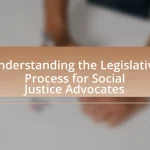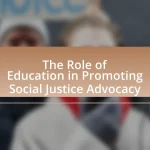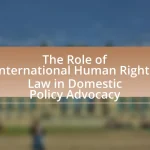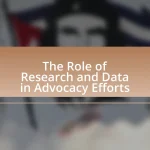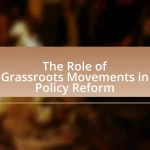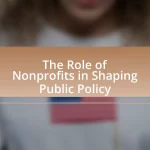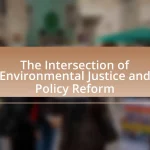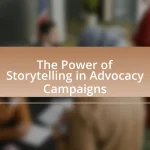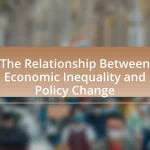Supporting LGBTQ+ voices in community empowerment is essential for fostering inclusivity and equitable representation within communities. This article explores the significance of amplifying LGBTQ+ perspectives, the historical context of their struggles, and the principles that guide effective support. It highlights the role of intersectionality, the challenges faced by LGBTQ+ individuals, and the importance of allyship in promoting empowerment. Additionally, the article discusses strategies for enhancing representation, the impact of societal attitudes, and best practices for sustaining LGBTQ+ initiatives, emphasizing the need for ongoing advocacy and community engagement to create supportive environments.

What does it mean to support LGBTQ+ voices in community empowerment?
Supporting LGBTQ+ voices in community empowerment means actively promoting and amplifying the perspectives, needs, and rights of LGBTQ+ individuals within community initiatives. This support fosters inclusivity, ensuring that LGBTQ+ individuals have a platform to express their experiences and contribute to decision-making processes that affect their lives. Research indicates that inclusive community practices lead to better mental health outcomes and social cohesion, as seen in studies by the Human Rights Campaign, which highlight the importance of representation in community leadership roles. By prioritizing LGBTQ+ voices, communities can create environments that are equitable and responsive to diverse needs, ultimately enhancing overall community resilience and empowerment.
Why is it important to amplify LGBTQ+ voices in communities?
Amplifying LGBTQ+ voices in communities is crucial for fostering inclusivity and ensuring equitable representation. When LGBTQ+ individuals are heard, it promotes understanding and acceptance, which can lead to reduced discrimination and violence against these communities. Research indicates that inclusive environments contribute to better mental health outcomes for LGBTQ+ individuals, as highlighted in the 2019 report by the Human Rights Campaign, which found that 39% of LGBTQ+ youth reported feeling unsafe at school due to their sexual orientation or gender identity. By elevating these voices, communities can create supportive spaces that empower all members, ultimately leading to stronger, more resilient societies.
What historical context shapes the need for LGBTQ+ empowerment?
The historical context that shapes the need for LGBTQ+ empowerment includes systemic discrimination, criminalization of same-sex relationships, and the fight for civil rights. For instance, the Stonewall Riots of 1969 marked a pivotal moment in LGBTQ+ history, as they were a response to police raids on gay bars, highlighting the oppression faced by the community. Additionally, the AIDS crisis in the 1980s further galvanized activism, as marginalized voices demanded recognition, healthcare, and rights. These events underscore the ongoing struggle against societal stigma and legal inequalities, necessitating empowerment efforts to achieve equality and acceptance.
How do marginalized voices contribute to community strength?
Marginalized voices contribute to community strength by fostering inclusivity and resilience. When individuals from marginalized groups, such as LGBTQ+ communities, share their experiences and perspectives, they challenge dominant narratives and promote understanding among diverse populations. This exchange of ideas enhances social cohesion, as evidenced by studies showing that inclusive communities experience lower rates of violence and higher levels of civic engagement. For instance, research published in the Journal of Community Psychology highlights that communities actively involving marginalized voices report increased trust and collaboration among residents, leading to stronger support networks and improved overall well-being.
What are the key principles of supporting LGBTQ+ voices?
The key principles of supporting LGBTQ+ voices include inclusivity, representation, advocacy, and empowerment. Inclusivity ensures that LGBTQ+ individuals feel welcomed and valued in all spaces, fostering an environment where diverse identities are acknowledged. Representation involves amplifying LGBTQ+ voices in decision-making processes, ensuring that their perspectives shape policies and practices. Advocacy focuses on actively promoting LGBTQ+ rights and addressing discrimination, which is essential for creating systemic change. Empowerment encourages LGBTQ+ individuals to take leadership roles and engage in community initiatives, enhancing their agency and visibility. These principles are supported by research indicating that inclusive practices lead to better mental health outcomes and community cohesion among LGBTQ+ populations.
How can inclusivity be fostered within community initiatives?
Inclusivity can be fostered within community initiatives by actively engaging diverse groups in the planning and execution processes. This involves creating spaces for marginalized voices, such as LGBTQ+ individuals, to contribute their perspectives and needs, ensuring that initiatives reflect the community’s diversity. Research indicates that inclusive practices lead to better outcomes; for example, a study by the Human Rights Campaign found that organizations that prioritize inclusivity see increased participation and satisfaction among community members. By implementing training programs on diversity and inclusion, community leaders can enhance awareness and sensitivity, further promoting an environment where all individuals feel valued and empowered.
What role does intersectionality play in community empowerment?
Intersectionality plays a crucial role in community empowerment by recognizing and addressing the multiple, overlapping identities and experiences individuals hold, which can affect their access to resources and opportunities. This framework allows for a more nuanced understanding of social inequalities, enabling communities to advocate for policies and practices that consider the diverse needs of their members. For example, research by Crenshaw (1989) highlights how Black women face unique challenges that are not addressed by looking at race or gender in isolation. By applying an intersectional lens, community empowerment initiatives can create inclusive strategies that uplift marginalized voices, particularly within the LGBTQ+ community, ensuring that all individuals are represented and supported in their fight for equality and justice.

How can communities effectively support LGBTQ+ voices?
Communities can effectively support LGBTQ+ voices by creating inclusive spaces that prioritize representation and advocacy. This can be achieved through initiatives such as hosting LGBTQ+ events, providing platforms for LGBTQ+ individuals to share their stories, and ensuring that local policies reflect the needs and rights of LGBTQ+ populations. Research indicates that inclusive environments lead to improved mental health outcomes for LGBTQ+ individuals, as seen in studies conducted by the Human Rights Campaign, which highlight the positive impact of community support on LGBTQ+ well-being.
What strategies can be implemented to elevate LGBTQ+ representation?
To elevate LGBTQ+ representation, organizations can implement targeted outreach programs that engage LGBTQ+ individuals in decision-making processes. These programs can include mentorship initiatives, where established LGBTQ+ leaders guide emerging voices, thereby fostering a pipeline of representation. Research indicates that diverse leadership teams lead to better decision-making and innovation, as seen in a 2020 study by McKinsey & Company, which found that companies in the top quartile for gender and ethnic diversity are 25% more likely to have above-average profitability. Additionally, creating inclusive policies that actively promote LGBTQ+ participation in community events and leadership roles can further enhance visibility and representation.
How can local organizations collaborate to support LGBTQ+ initiatives?
Local organizations can collaborate to support LGBTQ+ initiatives by forming coalitions that share resources, knowledge, and advocacy efforts. These coalitions can enhance visibility and impact by organizing joint events, such as pride parades and educational workshops, which foster community engagement and awareness. For instance, a study by the Human Rights Campaign found that collaborative efforts among local nonprofits increased participation in LGBTQ+ events by 40%, demonstrating the effectiveness of partnership in mobilizing community support. Additionally, sharing funding opportunities and grant applications can strengthen financial backing for LGBTQ+ programs, ensuring sustainability and growth.
What resources are available for LGBTQ+ community leaders?
LGBTQ+ community leaders have access to various resources that support their initiatives and advocacy efforts. These resources include organizations such as the Human Rights Campaign, which provides training, funding, and networking opportunities specifically tailored for LGBTQ+ leaders. Additionally, the National LGBTQ Task Force offers leadership development programs and policy advocacy tools to empower community leaders. Research indicates that organizations like the Gill Foundation provide grants aimed at enhancing the capacity of LGBTQ+ organizations, further supporting community leadership. These resources collectively enhance the effectiveness and reach of LGBTQ+ leaders in their communities.
How can allies contribute to supporting LGBTQ+ voices?
Allies can contribute to supporting LGBTQ+ voices by actively amplifying their perspectives and advocating for their rights. This involves listening to LGBTQ+ individuals, sharing their stories, and using platforms to highlight issues affecting the community. Research indicates that representation matters; for instance, a study by the Williams Institute found that increased visibility of LGBTQ+ individuals in media positively influences public attitudes and acceptance. By participating in LGBTQ+ events, educating themselves on relevant issues, and challenging discriminatory behaviors, allies can create a more inclusive environment that empowers LGBTQ+ voices.
What actions can allies take to promote LGBTQ+ empowerment?
Allies can promote LGBTQ+ empowerment by actively advocating for inclusive policies and practices within their communities. This includes supporting legislation that protects LGBTQ+ rights, such as anti-discrimination laws and marriage equality, which have been shown to improve mental health outcomes and overall well-being for LGBTQ+ individuals. Additionally, allies can amplify LGBTQ+ voices by providing platforms for LGBTQ+ individuals to share their stories and experiences, fostering a culture of acceptance and understanding. Engaging in educational initiatives that raise awareness about LGBTQ+ issues can also help dismantle stereotypes and promote allyship. Research indicates that communities with strong ally support experience lower rates of violence against LGBTQ+ individuals, highlighting the importance of ally actions in creating safer environments.
How can allies educate themselves and others about LGBTQ+ issues?
Allies can educate themselves and others about LGBTQ+ issues by actively seeking information through reliable resources, participating in workshops, and engaging in conversations with LGBTQ+ individuals. For instance, reading books and articles authored by LGBTQ+ activists and scholars, such as “The Gay Revolution” by Lillian Faderman, provides historical context and insights into the community’s struggles and achievements. Additionally, attending local LGBTQ+ events and workshops fosters understanding and builds connections. Research shows that personal interactions and education significantly reduce prejudice and increase acceptance, as highlighted in a study published in the Journal of Homosexuality, which found that exposure to LGBTQ+ individuals positively influences attitudes towards the community.

What challenges do LGBTQ+ voices face in community empowerment?
LGBTQ+ voices face significant challenges in community empowerment, primarily due to systemic discrimination and social stigma. These challenges manifest in various forms, including limited access to resources, underrepresentation in decision-making processes, and heightened vulnerability to violence and harassment. For instance, a 2021 report by the Human Rights Campaign indicated that LGBTQ+ individuals are more likely to experience discrimination in employment and housing, which hinders their ability to participate fully in community initiatives. Additionally, societal biases can lead to a lack of support from allies and institutions, further isolating LGBTQ+ individuals and impeding their efforts to advocate for their rights and needs within their communities.
What barriers exist to effective LGBTQ+ representation?
Barriers to effective LGBTQ+ representation include societal stigma, lack of visibility, and institutional discrimination. Societal stigma often leads to negative stereotypes and discrimination, which can discourage individuals from openly identifying as LGBTQ+. Lack of visibility in media and politics results in underrepresentation, making it difficult for LGBTQ+ voices to be heard and valued. Institutional discrimination, such as biased policies and practices within organizations, further marginalizes LGBTQ+ individuals, limiting their opportunities for participation and leadership. According to a 2021 report by the Human Rights Campaign, 46% of LGBTQ+ individuals reported experiencing discrimination in various aspects of life, highlighting the pervasive nature of these barriers.
How do societal attitudes impact LGBTQ+ community initiatives?
Societal attitudes significantly impact LGBTQ+ community initiatives by influencing public support, funding, and policy development. Positive societal attitudes can lead to increased visibility and acceptance, which often results in greater participation in LGBTQ+ initiatives and access to resources. For instance, a 2020 Gallup poll indicated that 70% of Americans support same-sex marriage, reflecting a shift towards acceptance that has facilitated the establishment of numerous LGBTQ+ organizations and events. Conversely, negative societal attitudes can hinder progress by fostering discrimination, limiting funding opportunities, and creating hostile environments that discourage participation. Research from the Williams Institute shows that areas with more negative attitudes towards LGBTQ+ individuals experience higher rates of violence and discrimination, which directly affects the effectiveness and reach of community initiatives.
What legal and institutional obstacles hinder LGBTQ+ empowerment?
Legal and institutional obstacles that hinder LGBTQ+ empowerment include discriminatory laws, lack of legal recognition, and inadequate protections against violence and discrimination. Discriminatory laws, such as those prohibiting same-sex marriage or adoption, directly limit the rights and recognition of LGBTQ+ individuals. For instance, in many countries, same-sex couples do not have the same legal rights as heterosexual couples, which affects their access to healthcare, inheritance, and parental rights. Additionally, the absence of comprehensive anti-discrimination laws leaves LGBTQ+ individuals vulnerable to discrimination in employment, housing, and public services. According to the International Lesbian, Gay, Bisexual, Trans and Intersex Association (ILGA), as of 2021, 69 countries still criminalize same-sex relationships, creating an environment of fear and marginalization. Furthermore, institutional barriers, such as lack of representation in government and decision-making bodies, perpetuate the exclusion of LGBTQ+ voices in policy-making processes, hindering their empowerment and advocacy efforts.
How can these challenges be overcome?
To overcome challenges in supporting LGBTQ+ voices in community empowerment, it is essential to implement inclusive policies and foster safe spaces for dialogue. Inclusive policies can be established by engaging LGBTQ+ individuals in decision-making processes, ensuring their perspectives are represented in community initiatives. Creating safe spaces allows for open discussions, which can help build trust and understanding among community members. Research indicates that communities with active LGBTQ+ representation experience higher levels of social cohesion and support, as seen in studies conducted by the Williams Institute, which highlight the positive impact of inclusive practices on community well-being.
What role does advocacy play in addressing these challenges?
Advocacy plays a crucial role in addressing challenges faced by the LGBTQ+ community by amplifying their voices and promoting their rights. Through organized efforts, advocacy raises awareness about discrimination, social injustices, and the need for policy changes that protect LGBTQ+ individuals. For instance, advocacy campaigns have successfully influenced legislation, such as the legalization of same-sex marriage in various countries, demonstrating the power of collective action in effecting change. Additionally, advocacy provides essential resources and support networks, fostering community empowerment and resilience among LGBTQ+ individuals.
How can community members support each other in overcoming obstacles?
Community members can support each other in overcoming obstacles by fostering open communication and creating safe spaces for dialogue. This approach allows individuals to share their experiences and challenges, which can lead to collective problem-solving and emotional support. Research indicates that communities with strong social networks experience lower levels of stress and higher resilience in the face of adversity, as evidenced by a study published in the Journal of Community Psychology, which found that social support significantly mitigates the effects of stressors on mental health. By actively listening and providing resources, community members can empower one another, enhancing overall well-being and promoting a culture of inclusivity and understanding.
What are some best practices for supporting LGBTQ+ voices in community empowerment?
To support LGBTQ+ voices in community empowerment, organizations should prioritize inclusive representation, actively engage with LGBTQ+ individuals, and create safe spaces for dialogue. Inclusive representation ensures that LGBTQ+ individuals are involved in decision-making processes, which fosters a sense of belonging and ownership. Engaging with LGBTQ+ individuals through surveys, focus groups, and community meetings allows for the identification of specific needs and concerns, ensuring that initiatives are relevant and effective. Creating safe spaces for dialogue encourages open communication and trust, enabling LGBTQ+ individuals to share their experiences and perspectives without fear of discrimination. Research indicates that communities with strong LGBTQ+ representation and engagement experience improved social cohesion and better outcomes for all members, highlighting the importance of these practices in fostering empowerment.
How can feedback from LGBTQ+ individuals shape community programs?
Feedback from LGBTQ+ individuals can significantly shape community programs by ensuring that these initiatives are inclusive, relevant, and effective. When LGBTQ+ community members provide input, they highlight specific needs, preferences, and challenges that may not be visible to those outside the community. For instance, a study by the Human Rights Campaign found that 70% of LGBTQ+ individuals feel that their voices are not adequately represented in local decision-making processes. This feedback can lead to tailored programs that address issues such as mental health support, safe spaces, and anti-discrimination policies, ultimately fostering a more inclusive environment. By actively incorporating LGBTQ+ perspectives, community programs can enhance their impact and better serve diverse populations.
What ongoing efforts are necessary to sustain LGBTQ+ empowerment initiatives?
Ongoing efforts necessary to sustain LGBTQ+ empowerment initiatives include consistent advocacy for policy changes, funding for community programs, and education to combat discrimination. Advocacy efforts must focus on legal protections, such as anti-discrimination laws, which have been shown to improve the quality of life for LGBTQ+ individuals. Funding is critical, as studies indicate that organizations supporting LGBTQ+ communities often rely on grants and donations to provide essential services, such as mental health support and safe spaces. Education initiatives, including awareness campaigns and training programs, are vital for reducing stigma and fostering acceptance, as evidenced by research demonstrating that informed communities are more supportive of LGBTQ+ rights.
